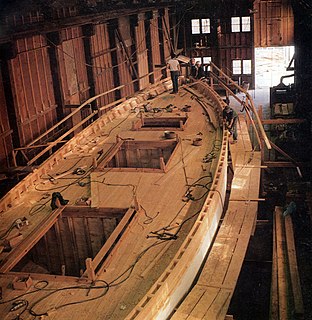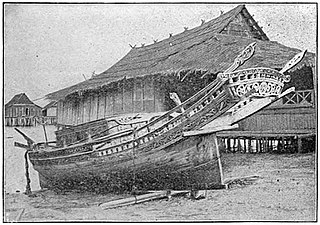
A boat is a watercraft of a large range of type and size. Ships are generally distinguished from boats based on their larger size, shape, and cargo or passenger capacity, and their ability to carry boats.

A hull is the watertight body of a ship or boat. The hull may open at the top, or it may be fully or partially covered with a deck. Atop the deck may be a deckhouse and other superstructures, such as a funnel, derrick, or mast. The line where the hull meets the water surface is called the waterline.
Seamanship is the art of operating a ship or boat.

On boats and ships, the keel is either of two parts: a structural element that sometimes resembles a fin and protrudes below a boat along the central line, or a hydrodynamic element. These parts overlap. As the laying down of the keel is the initial step in the construction of a ship, in British and American shipbuilding traditions the construction is dated from this event. Only the ship's launching is considered more significant in its creation.

An inflatable boat is a lightweight boat constructed with its sides and bow made of flexible tubes containing pressurised gas. For smaller boats, the floor and hull is often flexible, while for boats longer than 3 metres (9.8 ft), the floor typically consists of three to five rigid plywood or aluminium sheets fixed between the tubes, but not joined rigidly together. Often the transom is rigid, providing a location and structure for mounting an outboard motor.

Boat building is the design and construction of boats and their systems. This includes at a minimum a hull, with propulsion, mechanical, navigation, safety and other systems as a craft requires.
The Aberdonia is a British pre-war motor yacht moored at Chelsea Harbour. Built by the Thornycroft ship yard and launched in 1935 Aberdonia has a rich history, former uses include a patrol boat, mine sweeper and is one of the Little ships of Dunkirk.

Anti-submarine warfare is a branch of underwater warfare that uses surface warships, aircraft, or other submarines to find, track, and deter, damage, or destroy enemy submarines.

The naval history of China dates back thousands of years, with archives existing since the late Spring and Autumn period about the ancient navy of China and the various ship types used in war. China was the leading maritime power in the years 1405–1433, when Chinese shipbuilders began to build massive oceangoing junks. In modern times, the current Mainland Chinese and Taiwanese governments continue to maintain standing navies with the People's Liberation Army Navy and the Republic of China Navy, respectively.

The Project 205 Moskit (mosquito) more commonly known by their NATO reporting name Osa, are a class of missile boats developed for the Soviet Navy in the late 1950s. Until 1962 this was classified as a large torpedo boat.

The draft or draught of a ship's hull is the vertical distance between the waterline and the bottom of the hull (keel), with the thickness of the hull included; in the case of not being included the draft outline would be obtained. Draft determines the minimum depth of water a ship or boat can safely navigate.

The Rheinmetall Oerlikon Millennium Gun or Rheinmetall GDM-008 is a close-in weapon system designed by Rheinmetall Air Defence AG for mounting on ships. It is based on the 35/1000 revolver gun land based air defense system, and uses AHEAD ammunition.
The Beijiao 39 class dispatch boat is a class of little known naval auxiliary ship currently in service with the People's Liberation Army Navy (PLAN).
Beijiao 57 class dispatch boat is a class of little known naval auxiliary ship currently in service with the People's Liberation Army Navy (PLAN). The name of this class is after the first unit commissioned, with the exact type still remains unknown, and a total of eleven units of this class have been confirmed in active service as of mid-2010s, making this class the most numerous dispatch boats in service with the Chinese navy.
Nanjiao 90 class dispatch boat is a class of little known naval auxiliary ship currently in service with the People's Liberation Army Navy (PLAN). The name of this class is after the first unit commissioned, with the exact type still remains unknown, and a total of two units of this class have been confirmed in active service as of mid-2010s. Nanjiao 90 class has a narrow landing ramp built in the bow, the only Chinese naval dispatch boat with this feature.

Lepa, also known as lipa or lepa-lepa, are indigenous ships of the Sama-Bajau people in the Philippines, Malaysia, and Indonesia. They were traditionally used as houseboats by the seagoing Sama Dilaut. Since most Sama have abandoned exclusive sea-living, modern lepa are instead used as fishing boats and cargo vessels.
This page is based on this
Wikipedia article Text is available under the
CC BY-SA 4.0 license; additional terms may apply.
Images, videos and audio are available under their respective licenses.












